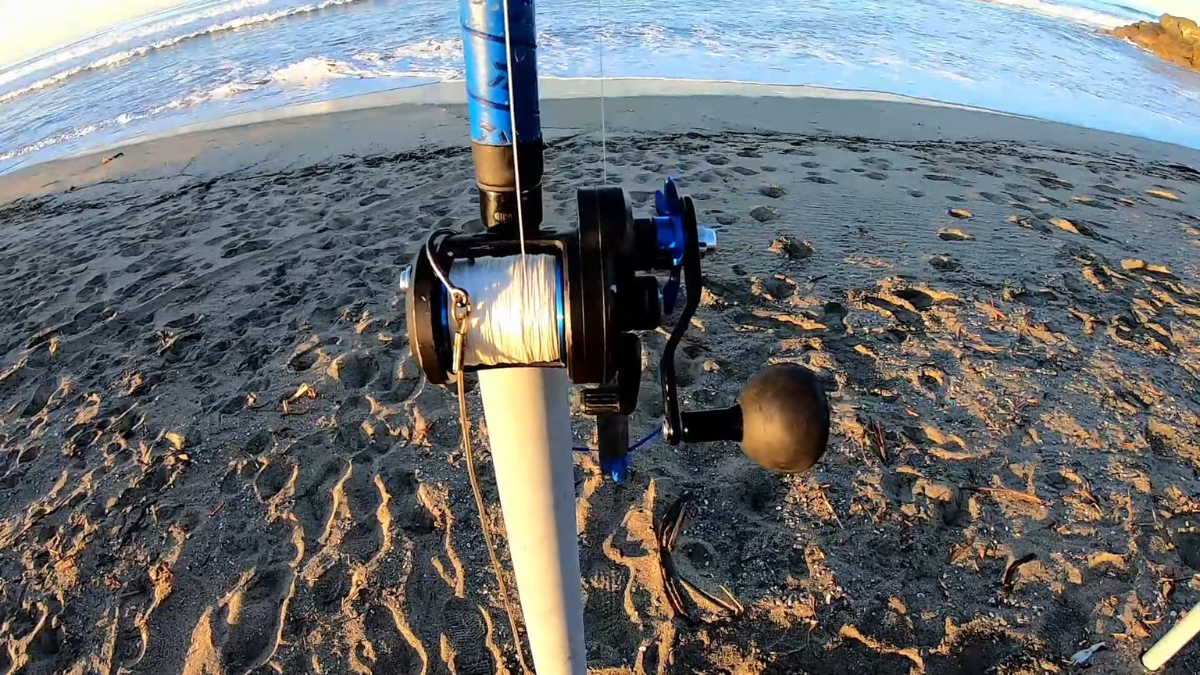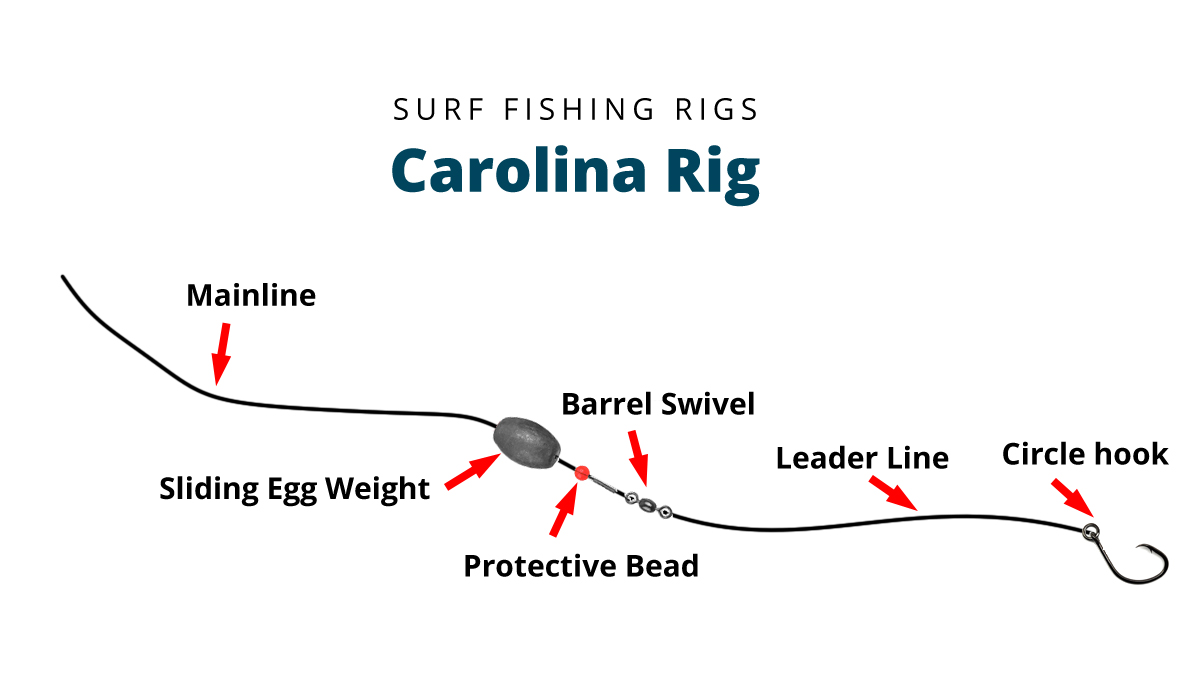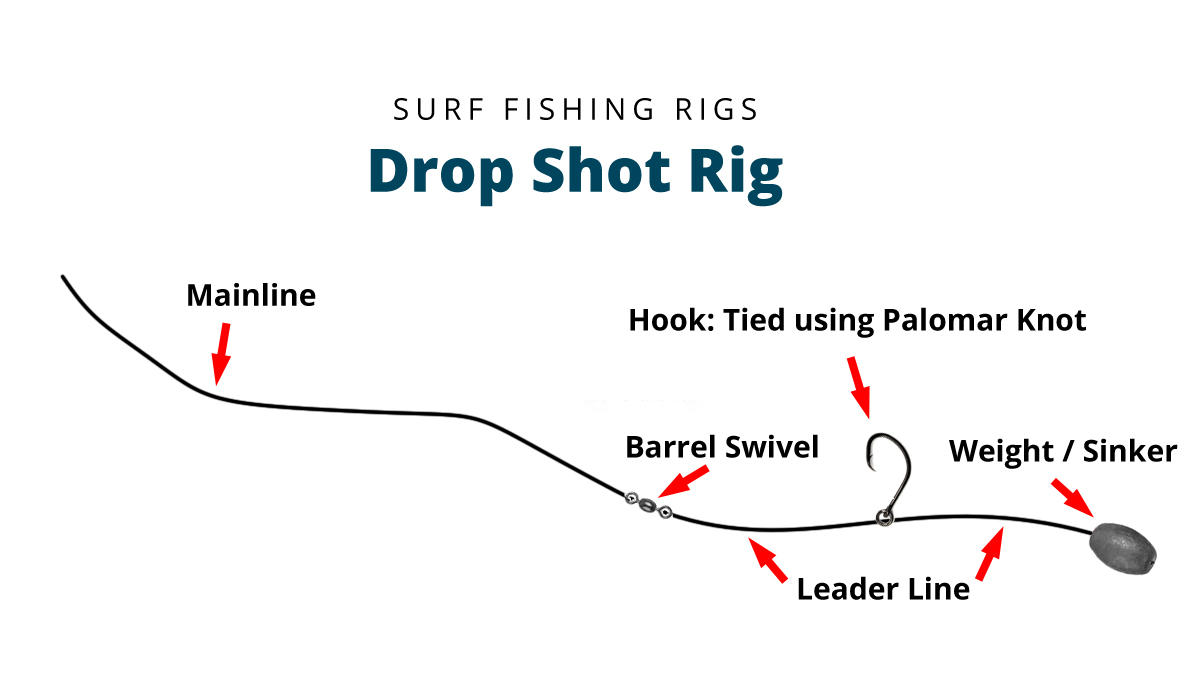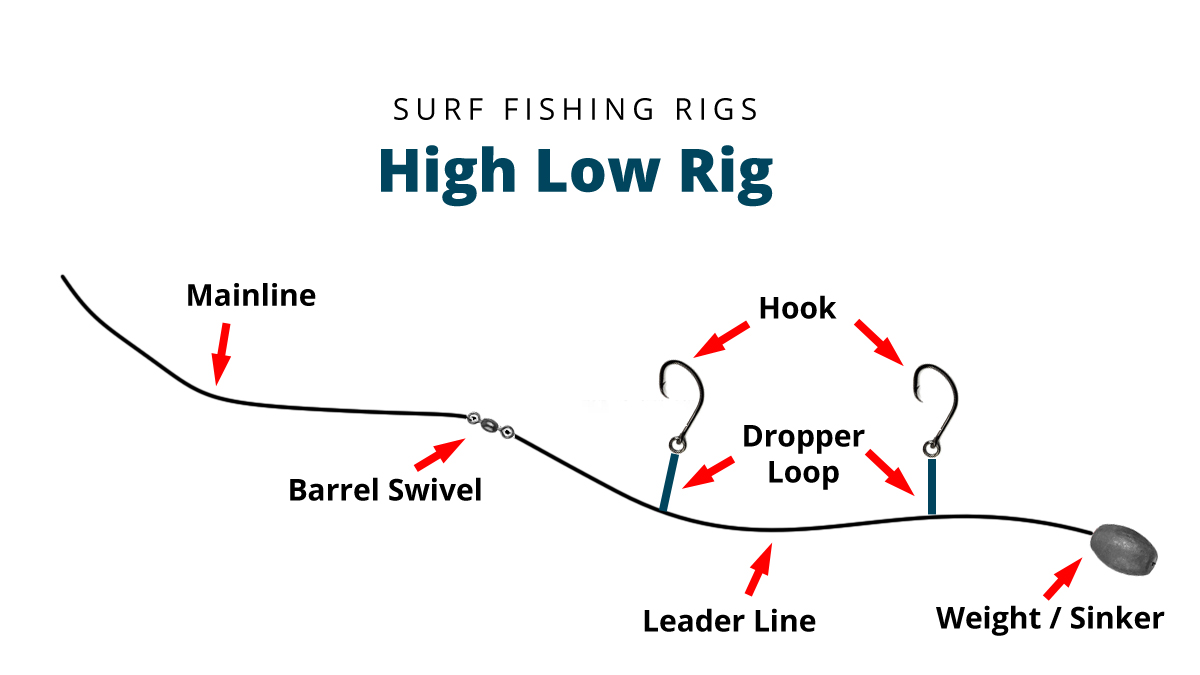Ah, surf fishing! Nothing beats the thrill of casting into those rolling waves and waiting with bated breath to see what comes up on the line.
It’s a pastime that has been attracting anglers for generations, and it’s no surprise why: being able to catch fish in such a beautiful environment is an unbeatable experience. But if you want your surf fishing trips to be successful, you need reliable surf fishing rigs.
Whether you’re looking for tricks of the trade or just advice from seasoned pros, this post covers everything there is to know about making intuitive beach fishing surf fishing rigs – so grab your gear and let’s get started!

What Are Surf Fishing Rigs?
Surf fishing rigs are specialized tackle used to catch fish in saltwater. They are often fished from the shoreline or a pier, and consist of a terminal tackle setup that is designed to present a bait or lure in an attractive manner while allowing for minimal tangles during casting.

Surf fishing rigs often feature multiple hooks, swivels, weights, and beads to create a unique bait presentation style that can be tailored for different types of fish. Additionally, surf fishing rigs typically come with a variety of leader lengths and weights, allowing anglers to customize the rig for specific conditions.
By using different rigs and adjusting the components accordingly, anglers can maximize their chances of catching their target species in various water environments.
How Does Surf Fishing Rigs Work?
Surf fishing rigs are designed to withstand the rigors of ocean casting while also presenting bait or lure in an attractive manner.
To achieve this, surf fishing rigs typically feature multiple hooks, swivels and weights that help keep the rig from tangling during casting.
Additionally, many rigs come with a variety of leader lengths and weights that can be adjusted for different water depths and conditions.
Once the rig is set up, it’s time to bait the hooks. Depending on the type of fish you’re after, you may need to use a variety of baits such as live or cut baitfish, shellfish, worms, eels, squid or artificial lures.
Once the bait is secured onto the hooks, it’s time to cast away and wait for the fish to bite!
What Are The Different Types Of Surf Fishing Rigs?
There are countless types of surf fishing rigs available on the market today, each designed for specific conditions and target species. Here are some of the most popular types:
- Single hook: The Single Hook Rig is the most basic and versatile of surf fishing rigs. As the name suggests, it employs a single hook at the end of the line. The simplicity of this rig makes it a great choice for novice anglers or those testing out new fishing grounds.You can adjust the size of the hook and type of bait according to the species you’re targeting. The single hook rig is ideal for catching a variety of fish, from small flatfish and porgies to larger species such as bluefish and striped bass.
- Double Hook: The Double Hook Rig, as the name implies, features two hooks instead of one, effectively doubling your chances of catching a fish. This rig is particularly beneficial when there is a high concentration of fish in the surf.With two pieces of bait in the water instead of one, you can attract more fish to your line. Each hook can be baited with the same or different types of bait to appeal to a variety of species. For example, you could use a piece of shrimp on one hook and a piece of squid on the other to attract different species of fish.
- Triple Hook: The Triple Hook Rig takes the basic concept of the Double Hook Rig and adds another layer of opportunity. As the name would suggest, this rig features three hooks, dramatically increasing your chances of catching a fish. This rig is particularly useful when fishing in areas teeming with fish.However, the Triple Hook Rig does require a high level of skill to set up and manage effectively. It also increases the likelihood of tangles during casting, so it’s usually recommended for more experienced surf anglers who have a good understanding of bait presentation and casting techniques.
| Rig Type | Description | Benefits | Considerations |
|---|---|---|---|
| Single Hook | Basic and versatile rig with a single hook at the end of the line. Ideal for novice anglers and various species. | Simple, versatile, suitable for different species and conditions. | Limited bait variety, less enticing for certain fish. |
| Double Hook | Features two hooks to increase chances of catching fish. Great for areas with high fish concentration. | Doubles chances of catching fish, can use different baits on each hook. | More complex setup, potential for tangles during casting. |
| Triple Hook | Three-hook rig for maximizing chances of catching fish in fish-rich areas. Requires skill and experience. | Higher chances of catching fish, effective in fish-rich spots. | Complex setup, increases likelihood of tangles, more suitable for experienced anglers. |
These surf fishing rigs offer varying levels of complexity and effectiveness depending on the fishing conditions, target species, and angler’s skill level.
How To Rig For Surf Fishing?
When rigging for surf fishing, it’s important to consider a few key factors such as the type of fish you’re targeting, the water conditions and currents, and the bait you plan to use. Here are some tips for getting your rig ready:
- Start with a strong leader material that is suitable for saltwater casting. A fluorocarbon leader line is often a good choice as it is nearly invisible in the water and strong enough to withstand frequent casting.
- Choose the appropriate hook size for the bait you plan to use. Smaller hooks are best for smaller baits, while larger hooks can be used when targeting bigger fish or larger pieces of bait.
- Tie your swivel and/or weight to the leader material with a strong knot such as the clinch or palomar.
- Place your hook(s) onto the swivel. For single hook rigs, place one lure or bait on the hook while for double and triple hook rigs, use two or three lures respectively.
- Finally, attach your line to the swivel with a strong knot.
By following these steps, you’ll be ready to cast your rig and start catching fish!
When fishing in the surf, it’s important to remember that each species of fish has its own preferences when it comes to bait and rigs. It’s also important to adjust your rig for different water depths and conditions.
What Are Some Of The Best Surf Fishing Rigs?
Surf fishing rigs come in all shapes and sizes, so it can be difficult to choose the right one for your needs. Here are some of the most popular rigs that deliver great results:
Fish Finder
The Fish Finder Rig is best used when you’re dealing with fish that are sensitive to resistance, like striped bass or flatfish. The sliding sinker on this rig allows the fish to take the bait and swim away without feeling the weight of the line. This rig is also excellent for surf fishing during high tide when fish are more likely to be closer to the shore.
The Fish Finder Rig is particularly effective for catching bottom-feeding fish. Striped bass, fluke, flounder, redfish, and drum species all respond well to this rig. It’s also suitable for larger predatory fish, including sharks and rays, as the sliding sinker allows for live bait to swim freely and naturally.
To set up a Fish Finder Rig, you’ll need a few key pieces of tackle.
- Firstly, a pyramid sinker of the appropriate weight for your fishing conditions, typically between 2 to 6 ounces.
- Secondly, a plastic fish finder or sinker slide to allow the sinker to slide freely along the line.
- Next, a barrel swivel to prevent line twists and to connect the main line to your leader. A monofilament or fluorocarbon leader line, usually between 20 to 60 lbs test, depending on your target species, is also required.
- Lastly, you’ll need a suitable hook for your bait, usually a circle or octopus hook in sizes ranging from 1/0 to 8/0 depending on the size of fish you’re targeting.
Carolina Rig
The Carolina Rig is a versatile surf fishing rig that can be used in a variety of situations. It is particularly effective in areas with sandy or muddy bottoms.
This rig can be used at any time of the year, but it is especially productive during the warmer months when fish are more active and feeding closer to the shore. It also works well in various water conditions, including clear, murky, calm, or choppy waters.
The Carolina Rig is known for its ability to target a wide range of species. It is particularly effective for bottom-feeding fish such as flounder, redfish, and sea bass.
However, it can also be used to catch larger predatory species such as sharks and rays. With the right bait, you can even attract and catch highly prized game fish like striped bass and bluefish.

To set up a Carolina Rig, you’ll need the following tackle:
- Main Line: This can be either a monofilament or braided fishing line, typically between 15 to 30 lbs test.
- Leader Line: A fluorocarbon leader line, usually between 20 to 50 lbs test, is ideal for its low visibility and resistance to abrasions.
- Sinker: A bullet sinker is most commonly used for a Carolina Rig. The weight can vary depending on the current and water depth, but typically ranges from 1/2 to 2 ounces.
- Bead: A small plastic bead is used to protect the knot and create noise that can attract fish.
- Swivel: A barrel or snap swivel is used to connect the main line to the leader and prevent line twists.
- Hook: The hook size and type depend on the bait and target species. For most surf species, a size 1/0 to 4/0 circle or octopus hook is a good choice.
Drop Shot Rig
The drop shot rig is a versatile and effective fishing technique that can be used in both freshwater and saltwater. It’s most often used for targeting bottom-dwelling fish such as perch, sea bass, snapper, walleye, and whitefish.
The lure or bait is suspended above the hook which allows the angler to work it through the water column with subtle movements. This technique is especially effective in shallow, clear waters when fish are spooked by an incoming bait or line.

The drop shot rig consists of a few basic components:
- Main Line: A monofilament or braided line, typically between 8 to 20 lbs test depending on the targeted species and water conditions.
- Leader Line: A fluorocarbon leader line, usually between 10 to 20 lbs test. This allows for a more natural presentation of the bait and prevents the line from being seen by wary fish.
- Sinker: A drop shot weight is used to keep the rig in place and allow your bait or lure to move freely. The weight can range from 1/8 to 1 ounce depending on the depth and current.
- Hook: The hook size and type must be suited to the targeted species. A size 4 or 6 circle hook is usually a good choice for most surf fishing species.
High Low Rig
The High Low Rig is one of the most popular rigs for surf fishing. This rig works well in areas where the seafloor has a lot of irregularities, such as rocky or weedy bottoms. It’s also an effective technique for catching bigger fish that may be lurking further offshore.
This rig features two separate lines with hooks and weights attached to each end. The main line is weighted and connected to the leader lines, which can be either mono or fluorocarbon.
The High Low Rig is most effective when targeting larger predatory fish such as striped bass, bluefish, redfish, and sharks. It’s also known for its ability to target smaller fish species like panfish and sea trout.

To set up a High Low Rig, you’ll need the following tackle:
- Firstly, a main line of either monofilament or braided fishing line, typically between 30 to 50 lbs test.
- Next, two leader lines, usually between 10 to 20 lbs test. These can be either mono or fluorocarbon.
- Two lead weights are then attached to the ends of the leader lines. The weight depends on the depth and current but typically ranges from 2 to 6 ounces.
- Lastly, two suitable hooks for the bait or lure. A size 1/0 to 8/0 circle or octopus hook is usually a good choice.
Overall, it’s important to remember that when setting up any of these rigs, the tackle and bait should be chosen specifically for the species you’re targeting. This will make sure that your rig is as effective as possible and that your bait will be presented in a natural manner to draw in fish.
Factors To Consider For Selecting The Right Surf Fishing Rigs
There are a few factors to consider when selecting the right rigs for surf fishing.
Firstly, your target species and type of bait will determine which rig is most suitable. Different rigs are more effective for certain species, so it’s important to match the right tackle with the right fish.
Secondly, you should also think about the water conditions. Different rigs work better in different depths and current speeds, so it’s important to choose a rig that can handle the conditions you’ll be fishing in.
Lastly, the type of bottom structure should also be taken into account as some rigs are more suitable for sandy or weedy bottoms while others may be better suited for rocky or rubble-filled sea floors.
All these factors should help you to choose the best rigs for your surf fishing trip.
FAQs
What Time Of Day Is Ideal For Surf Fishing?
The best time to go surf fishing is usually around dawn and dusk. During these times, the fish are more active and may be more likely to take a bait or lure.
What Is The Fundamental Surf Fishing Setup?
The fundamental surf fishing setup consists of a casting rod and reel, an appropriate line strength for the target species, a lead sinker, one or two hooks with bait, and various other tackles such as swivels and beads.
Do I Need A Special Rod And Reel For Surf Fishing?
Yes, a special rod and reel are needed for surf fishing. The rod should be at least 8 to 10 feet long and suitable for casting out long distances, while the reel should have a good drag system and preferably an adjustable spool tensioner.
How To Pick The Best Tackle And Rigs For Surf Fishing?
The best tackle and rigs for surf fishing depend on the target species, water conditions, and seafloor structure. It’s important to match the right tackle with the right fish according to these factors in order to achieve the most effective results.
How To Use Surf Fishing Rigs?
Surf fishing rigs are designed to be relatively easy to use. All you need to do is attach the main line, leader lines, sinker, and hooks according to the instructions provided with the rig. Make sure that all components are securely fastened before casting out your line.
Conclusion
In conclusion, surf fishing is a great way to target different species in the ocean. With the right tackle and surf fishing rigs, it can be easy and enjoyable. When selecting the right rigs for surf fishing, remember to choose ones that are suited to the specific conditions, fish species, and bait you’ll be using. This will ensure that your rig is as effective as possible and will help you to catch more fish. Happy fishing!
source https://bassfishingarchives.com/surf-fishing-rigs/ by Clay Dyer

No comments:
Post a Comment